

Prague offensive in May 1945
During the WWII Czechoslovakia was devided - the eastern part was Slovak state following the Nazi politics and the today´s Czechia was Protektorat Böhmen und Mähren = Protectorate Bohemia and Moravia occupied by Hitler.
On May 5th, 1945, at six o'clock in the morning, to everyone's surprise, the radio began broadcasting exclusively in Czech. Suddenly Czech songs, which had been banned until then, sounded with ether.
"Everyone to Czech Radio! Czech people are shot here! Come as soon as possible! ” The announcer demanded repeatedly.
The insurgents were also encouraged by the BBC broadcast: “Hello, Prague! Hello, Prague! We call on our Czech Prague, whose people arose in a heroic liberation struggle, to expel the German invaders from the hundred-towered capital of our country. " BBC had a broadcasting in Czech language during the war - they began always with the words "Volá Londýn" = London calling.
At this time Hitler was already dead, a lot of European territory was set free and armies fighting against the Nazi Germany from all directions were approaching or already entered the Czech territory.
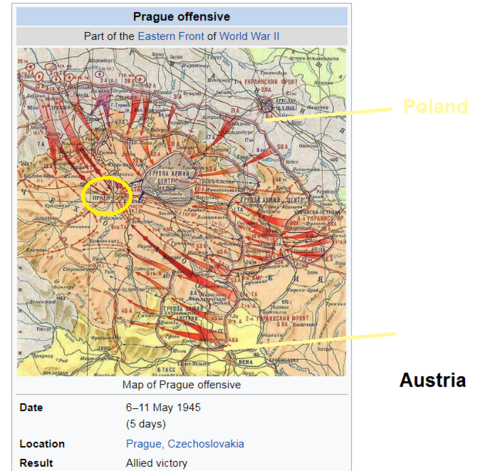
From Wikipedia
The Prague offensive (Russian: Пражская стратегическая наступательная операция, romanized: Prazhskaya strategicheskaya nastupatel'naya operatsiya, lit. 'Prague strategic offensive') was the last major military operation of World War II in Europe. The offensive was fought on the Eastern Front from 6 May to 11 May 1945. Fought concurrently with the Prague uprising, the offensive significantly helped the liberation of Czechoslovakia in 1945. The offensive was one of the last engagements of World War II in Europe and continued after Nazi Germany's unconditional capitulation on 8 May.
The city of Prague was ultimately liberated by the USSR during the Prague offensive. All of the German troops of Army Group Centre (Heeresgruppe Mitte) and many of Army Group Ostmark (formerly known as Army Group South) were killed or captured, or fell into the hands of the Allies after the capitulation.
The Prague operation was to be carried out by an attack from three sides towards Prague, while a substantial part of Bohemia was to be liberated. The troops of the 1st Ukrainian Front of Marshal I. S. Konev were to attack from Saxony, the troops of the 2nd Ukrainian Front under the command of Marshal Rodion Malinovsky were to attack from South Moravia and the 4th Ukrainian Front of General Andrei Jeremenko was to advance from northern Moravia and Silesia. At the beginning of May 1945, the situation changed significantly, when the Red Army conquered Berlin and German troops practically stopped resisting the Western Allies. On May 5, the Prague Uprising broke out and the insurgents asked for help.
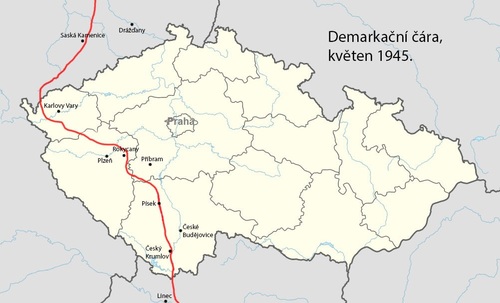 Demarcation line between WestAliens and Soviet army in May 1945
Demarcation line between WestAliens and Soviet army in May 1945
Soviet troops entered the fight with impressive force. The German armies had about 900,000 soldiers grouped in two army groups, Middle - Mitte and East Mark - Ostmark. However, part of this army advanced to Linz, and so it appears that the German Ostmark armies in southeastern Moravia numbered about 150,000 troops.
Against this still impressive force stood the 1st Ukrainian Front Konev, numbering 980,000 members (including 69,522 soldiers of the 2nd Polish Army, 5th Infantry Division and Tank Corps, the 2nd Ukrainian Front Malinovsky 710,000 members (including 139,432 soldiers of the 1st and 4th Romanian Army) and the 4th Ukrainian Front 410,000 members (including 48,400 soldiers of the 1st Czechoslovak Army Corps) The Red Army's troops consisted of 1,770,637 soldiers, 151 divisions, 14 tank and mechanized corps, 18 brigades. The Allied troops consisted of a total of 257,354 troops, and together they grouped three fronts and all armies theoretically 2,027,991 troops.
 Heart of Prague = Wenceslas square
Heart of Prague = Wenceslas square
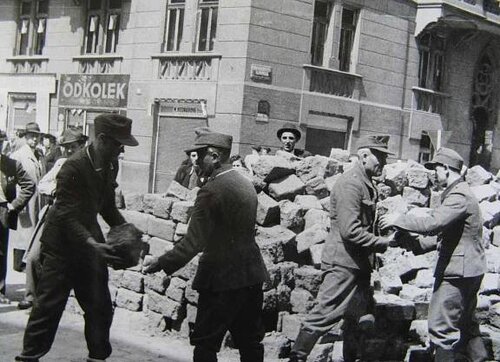
On May 7, attacks from the 2nd Ukrainian Front under the command of Marshal Rodion Malinovsky, who ended the Bratislava-Brno (today border between Czech and Slovak republic) operation, and the 4th Ukrainian Front, General Andrei Jeremenko, which had recently participated in the Ostrava-Opava operation (at the Polish border), began to attack from the west of Moravia. Other Soviet troops attacked through northern Austria towards České Budějovice.
The German armies in Prague capitulated on the afternoon of May 8 to the Czech National Council. German troops left the city by road to Beroun and Pilsen from 11 pm to 9 am the following day, May 9. (Pilsen = Plzeň is a town 100 kms west from capital Praha which was set free by US gen. Patton)
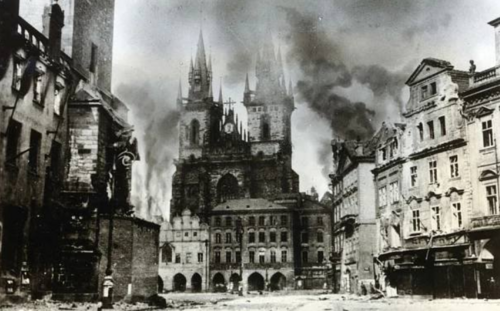 Praha, Old Town square
Praha, Old Town square
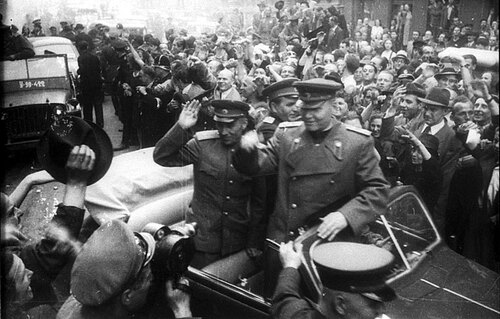 Soviet gen. Konev
Soviet gen. Konev
The fighting actions of the Red Army and allies on May 9 practically consisted of the persecution of German troops, while there were still small military clashes locally.
In the early morning hours of May 9, the troops of the 1st Ukrainian Front penetrated from the direction of Slaný and Veltrusy, and Rybalka's tanks were the first to arrive in Prague.
Early on the morning of May 10, the first-line troops of the Malinovsky 2nd Ukrainian Front arrived in Prague, and Pardubice was liberated by the 4th Ukrainian Front. 1st Czechoslovak Tank Brigade, which fought the last battles near Litovel 8.5. and continued to Svitavy and Kutná Hora arrived in Prague shortly after midnight on May 10. By May 11th, the last outbreaks of German resistance were being liquidated. Even then, however, Soviet troops and Allied soldiers of the Czechoslovak, Romanian and Polish armies cleaned the forests of proficient and hiding German soldiers.
World War II ended in Europe on Czech territory.
Thanks for reading
Margaret
